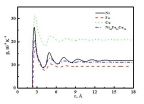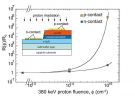Although significant advances have been made in the treatment and prevention of blood clots through new and improved therapies for clotting disorders, challenges remain in balancing the benefits and risks of these therapies. Specifically, while these treatments can reduce patients' risk of suffering potentially life-threatening clotting that can lead to heart attack, stroke, or pulmonary embolism, they can also lead to severe treatment-related bleeding. Blood clots also present a particular challenge for certain at-risk populations, specifically patients with cancer. One study presented today will unveil the first real-world safety data for a new class of oral anticoagulants that had mainly been previously evaluated in clinical trials. Two additional studies will explore the burden of blood clots for patients with cancer, including validating previous guidelines and proposing new preventive measures for minimizing clot risk. Another study will describe a targeted, experimental compound that appears to reduce clot risk without increasing bleeding, a critical marker of safety for anticoagulant therapy.
"The scientific community is on a continual path of progress to introduce safe and effective therapies that can both treat and prevent blood clots," said Mary Cushman, MD, moderator of the press conference and Professor of Medicine at the University of Vermont in Burlington. "Studies presented today evaluating new and standard treatments and determining optimal treatment strategies for cancer patients with blood clots represent advancement in the field."
This press briefing will take place at 11 a.m. PST on Sunday, December 7, in rooms 236-238 of Moscone South, East Mezzanine.
Novel Anticoagulants Shown to be Safe, Effective Outside Clinical Trial Setting
Bleeding in Patients with Atrial Fibrillation Treated with Non Vitamin K Antagonist Oral Anticoagulants: A Population-Based Study [343]
For many years, the majority of patients with the heart rhythm disorder atrial fibrillation have taken warfarin, a type of drug known as a vitamin K antagonist (VKA), to reduce their risk of stroke and other complications. While effective, warfarin is a challenging treatment as patients must undergo regular monitoring to assess bleeding risk and there is no recommended standardized dose. Recently, three novel, non-VKA oral anticoagulants (NOACs) - dabigatran, apixaban, and rivaroxaban - have received approval from the U.S. Food and Drug Administration as VKA alternatives that may provide greater ease of use. While Phase III clinical trials have demonstrated that NOACs are at least as effective and as safe as warfarin, their associated bleeding risks outside of a controlled clinical trial setting have remained unclear.
To better determine the safety of NOACs in a real-world setting, investigators performed a population-based analysis of 18,249 patients with atrial fibrillation who began therapy with either a VKA (warfarin) or a NOAC (dabigatran or rivaroxaban) between January 1, 2011 and December 31, 2013. After examining the data, investigators observed that patients taking NOACs did not appear to suffer more bleeding episodes than those prescribed warfarin. Of all patients treated per 100-patient years with these therapies, 3.9 taking VKAs experienced bleeding episodes compared with 2.8 on 150 mg of dabigatran twice daily, 4.6 on 110 mg of dabigatran twice daily, and 4.3 on rivaroxaban. Investigators noted an increase in gastrointestinal bleeding in patients taking dabigatran and a reduction in intracranial bleeding among patients taking dabigatran or rivaroxaban. These findings are consistent with observations reported in clinical trials, by demonstrating that NOACs and VKAs have similar safety and efficacy in the real world as in clinical trials. "While our findings suggest that these new oral anticoagulants are safe, clinicians must remain vigilant about their use and screen patients for potential contraindications or high-risk features that may increase their likelihood of dangerous bleeding," said lead study author Martin H. Ellis, MD, of Meir Medical Center in Kfar Saba, Israel.
Dr. Ellis will present this study at 10:30 a.m. PST on Monday, December 8, in rooms 3018-3020 of Moscone West.
Low-Molecular-Weight Heparin More Effective Than Warfarin in Preventing Clot Recurrence in Cancer Patients
A Randomized Trial of Long-Term Tinzaparin, a Low Molecular Weight Heparin (LMWH), Versus Warfarin for Treatment of Acute Venous Thromboembolism (VTE) in Cancer Patients - the CATCH Study [LBA-2]
Venous thromboembolism (VTE) presents a significant challenge for cancer patients and their physicians. VTE includes deep-vein thrombosis, a blood clot that forms in a major vein of the leg or in the arms, pelvis, or other large veins in the body, as well as pulmonary embolism, a potentially deadly condition that occurs when the clot breaks off and travels to the lungs. While current clinical practice guidelines recommend the use of low-molecular-weight heparins (LMWH) rather than warfarin to reduce this risk, recommendations were based largely on a single trial. Given the lack of confirmatory trials or trials including different medications, warfarin remains a commonly used anticoagulant treatment in cancer patients.
To confirm previous findings that LMWH is superior to warfarin in preventing recurrent VTE among cancer patients, researchers enrolled 900 cancer patients with DVT or PE in a randomized, Phase III trial evaluating the efficacy and safety of the LMWH tinzaparin. Participants received either tinzaparin once daily for six months or tinzaparin once daily for five to 10 days followed by six months of warfarin. During the treatment period, 31 patients (6.9%) treated with tinzaparin experienced recurrent VTE compared with 45 (10%) patients treated with warfarin. While tinzaparin did not meet statistical significance in reducing recurrent VTE, the drug showed statistically significant activity in reducing recurrent DVT in veins above the knee. Researchers did not observe a difference in the mortality or incidence of major bleeding events (2.9% in the tinzaparin arm and 2.7% in the warfarin arm), but noted that significantly fewer patients experienced clinically relevant, non-major bleeding with tinzaparin than warfarin (11% vs 16%).
"As the largest randomized, controlled trial on the treatment of thrombosis among cancer patients, this study reinforces clinical guidelines supporting the use of low-molecular-weight heparins instead of warfarin to prevent recurrent blood clots," said lead study author Agnes Lee, MD, of the University of British Columbia in Vancouver, Canada.
Dr. Lee will present this study during the Late-Breaking Abstracts Session at 7:30 a.m. PST on Tuesday, December 9, in Hall D of Moscone North.
Anticoagulation After Incidental Pulmonary Embolism May Reduce Risk of Clot Recurrence in Cancer Patients
Risk of Recurrent Venous Thromboembolism and Major Bleeding in Cancer-Associated Incidental Pulmonary Embolism Amongst Treated and Untreated Patients: A Pooled Analysis of 926 Patients [590]
Blood clots in the lungs detected on computed tomography scans conducted for other purposes, known as incidental pulmonary emboli (IPE) are an increasing complication affecting cancer patients. While these clots are relatively common, knowledge about prognosis, optimal management, and recurrence risk is scarce.
To better understand the natural course of blood clots and possible treatment outcomes among cancer patients, researchers collected data on 926 cancer patients with IPE from 11 observational studies and ongoing registries. The primary aim of the study was to compare risk of clot reoccurrence, major bleeding, and death among cancer patients with IPE who had received anticoagulant treatment versus those who had not. Following a complete review of the data, investigators noted that the risk of developing a subsequent clot was nearly doubled in cancer patients with IPE who did not receive continued anticoagulant treatment (12%), compared to those that had received treatment either with low-molecular-weight heparins (LMWH; 6.2%) or vitamin K antagonists (VKAs; 6.4%). Major bleeding complications occurred more frequently in patients who received VKAs (13%) compared to those who received LMWH (3.9%). Six-month mortality was higher in untreated patients (47%) than in patients treated with LMWH (37%) and VKAs (28%). These findings suggest that anticoagulant therapy after IPE may reduce the risk of clot recurrence in cancer patients.
"While we previously had no evidentiary basis for anticoagulating cancer patients with incidental pulmonary embolism, this study provides a strong argument for always treating this population to prevent recurrence," said lead study author Tom van der Hulle, MD, of Leiden University Medical Center in the Netherlands. "Ideally, our findings should be confirmed in a randomized clinical trial. However, given our current and previous results, we believe that it would be ethically challenging and perhaps unfeasible to design a trial allocating patients with cancer-associated IPE to placebo."
Dr. van der Hulle will present this study at 4:30 p.m. PST on Monday, December 8, in rooms 3006-3008 of Moscone West.
Novel Compound Reduces Thrombosis Risk without Increased Bleeding
Factor XI Antisense Oligonucleotide for Prevention of Venous Thrombosis [LBA-1]
Patients undergoing total knee replacement have an increased risk of venous thromboembolism (VTE), related to the activation of a blood clotting factor at the surgical site. Preliminary data suggest that reducing factor XI (FXI), a central component in the intrinsic pathway of coagulation, might help prevent clotting without causing extra bleeding typically associated with other clot-busting drugs. This theory is further supported by evidence that patients born with FXI deficiency have a reduced risk of VTE.
To determine whether decreasing FXI would effectively prevent VTE without increasing bleeding risk, this study examined an injectable nucleic acid engineered to reduce FXI expression (FXI-ASO). Researchers randomized approximately 300 patients undergoing total knee replacement to receive FXI-ASO (either 200 or 300 mg) or the commonly used anticoagulant enoxaparin (40 mg), to compare the rates of postoperative VTE and bleeding among the two groups. Patients received subcutaneous injections of FXI-ASO beginning 36 days before surgery, to allow time for the treatment to interfere with FXI production, and received the last dose three days after surgery. Those in the control group received enoxaparin for at least eight days after their procedure. After surgery, patients receiving the higher dose of FXI-ASO had the lowest occurrence of VTE (4.2%, 3 of 71 patients) when compared to those receiving low-dose FXI-ASO (26.9%, 36 of 134 patients) or enoxaparin (30.4%, 21 of 69 patients). Further, patients receiving FXI-ASO had fewer bleeding episodes than patients receiving enoxaparin (bleeding rate of 2.6% in the high-dose FXI-ASO group compared with 2.8% in the FXI-ASO low-dose group and 8.3% for enoxaparin patients). While this novel treatment reduced the expression of FXI and VTE incidence, it did not increase the risk of bleeding and did not affect other components of coagulation.
"While modern anticoagulants effectively reduce the risk of blood clots after joint surgery, they come with an unfortunate side effect, which is an increased risk of sometimes dangerous, unwanted bleeding," said lead study author Harry Büller, MD, PhD, of the Academic Medical Center of the University of Amsterdam in the Netherlands. "While further confirmatory studies are necessary to validate the results, this study demonstrates that this blood clotting factor may be a significant target for the prevention and treatment of venous thrombosis and, as a result, may have a wide range of potential applications."
Dr. Büller will present this study during the Late-Breaking Abstracts Session at 7:30 a.m. PST on Tuesday, December 9, in Hall D of Moscone North.
INFORMATION:
American Society of Hematology 56th Annual Meeting
The study authors and press program moderator will be available for interviews after the press conference or by telephone. Additional press briefings will take place throughout the meeting on advances in lymphoma and myeloma treatment, immunotherapy, leukemia research, and anemia and novel care approaches. For the complete annual meeting program and abstracts, visit http://www.hematology.org/annual-meeting. Follow @ASH_hematology and #ASH14 on Twitter and like ASH on Facebook for the most up-to-date information about the 2014 ASH Annual Meeting.
The American Society of Hematology (ASH) is the world's largest professional society of hematologists dedicated to furthering the understanding, diagnosis, treatment, and prevention of disorders affecting the blood. For more than 50 years, the Society has led the development of hematology as a discipline by promoting research, patient care, education, training, and advocacy in hematology. The official journal of ASH is Blood, the most cited peer-reviewed publication in the field, which is available weekly in print and online.




